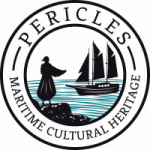
Views from the Aegean: the many aspects of fishing cultural heritage
PERICLES work in Greece focused on fishing cultural heritage in NE Aegean Sea. This region is a fisheries hub in the country and has some of the most productive marine and inland water ecosystems. Its turbulent history has left behind a rich and diverse cultural landscape. Fishing cultural heritage is prominent in the area but has been mostly unrecorded and underused. Fishermen in NE Aegean face a number of challenges, much like fishermen all over Europe, but here the loss of fishing CH and memory is particularly threatening. PERICLES set out to face this problem, frame it and explore how local communities, fisheries practitioners and managing bodies may participate in an effort to map their fishing cultural heritage, appreciate and use it as an asset, as something that is unique and valuable.
PERICLES team used semi-structured interviews along with video and audio recordings as one of their tools to explore and capture people’s views on fishing cultural heritage. Traditional knowledge and skills that are still surviving along with sentiments and individual or collective memories make FCH a kind of glue that binds communities together and create a strong sense of identity and belonging. These emotions are part of the fishermen “arsenal” when they are called to face contemporary crises and challenges in fishing, and their livelihoods.
From this rich visual and audio archive we created short videos that illustrate some of the issues that are prominent in people’s perception of their fishing cultural heritage. Four of them are presented here. For forthcoming ones, on folk fishing meteorology and fishing family history, check out our web site https://www.pericles-heritage.eu/leanr-about-maritime-culture-heritage-see-hear-do/
Sorting the fish nets
Greece has the largest fleet of small coastal fishing vessels in Europe with almost 15.000 fishing boats smaller than 12 m in length. Coastal fishermen face the most challenges: depleted fish stocks, fishing gear damage by predators such as dolphins, disproportionally high expenses, low fish prices in the market. Selling directly to the consumers from the boat can help them.
Sorting fish nets is one of the chores in the coastal fishing effort and it often creates a social space where news are shared, problems are discussed, bonds of friendship and companionship are forged.
We are grateful to the fishermen at Keramoti at Kavala whom we met in summer 2019. Music by N. Skalkotas “The Sea-Fishing Boat”
Fishing for razor shells in NE Aegean, Greece – The intangible aspect of fishing cultural heritage
The art of fishing for razor shells incorporates knowledge and embodied experience: the manufacture of the tool, the identification of the shells’ marks on the seabed, the movement of the fisher’s wrist at the moment of capture. They are all elements of the rich intangible fishing cultural heritage on the coasts of NE Aegean, Greece. Fishing for razor shells is strictly regulated for conservation reasons and this environmental measure threatens the traditional art and the gastronomy it supports.
We are grateful to Arvanitidis family for showing us how razor shells are harvested and also for their warm, generous hospitality!
Vistonis Lagoon and its dalyan
Vistonis lagoon is a protected wetland area, part of the National Park of Eastern Macedonia-Thrace, with diverse fauna and flora and unique geomorphological features. At the same time it is a particularly rich fishing ground which, even today, is exploited by traditional methods, mostly the dalyan run by a fishermen’s Cooperation. Clashes between the environmental and cultural values of this arrangement are constant.
We are grateful to the members of the fishermens’ Cooperation “Agios Nikolaos” for exhibiting the workings of the dalyan and their warm hospitality.
Music:Lament from North Epirus by Petro-Luca Chalkias
*Dalyan is a Turkish word that describes the fish capture arrangements in lagoons like those in this video but also, in a different context, the stationary tuna traps.
How to make salt fish at home: family memories and intangible cultural heritage
Fish processing transforms an abundant perishable resource, the fish, into food that has a long shelf life and can be transported over long distances. Fish processing creates products with new, unique taste. Salting is a simple processing technique which was already practiced in the Aegean as early as the prehistoric period and remains the same in its basic components even today. It is a robust element of the Aegean intangible fishing cultural heritage.
Salting fish for the needs of the household mobilizes knowledge, memories, dexterities and family relations, through the simple process of alternating layers of fish and salt in a pot, the waiting and the anticipating for the final result.
We are most grateful to Kostas and Eugenia Mylona who demonstrated fish salting and shared with us some ouzo and wonderful morsels of home-made salted anchovies.
Music: “Two little fish”, Gatinis Orchestra, 1950
